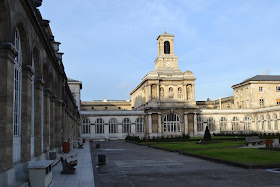 On an angle of the Avenue Wagram sits a salmon-hued hotel that would seemingly be more suited to Miami than Paris. With its curved façade and stepped upper levels, it looks a little like a cruise ship washed up on the corner of a Paris boulevard. Little surprise therefore to find out that its architect also worked on the design of the Normandie ocean liner.
On an angle of the Avenue Wagram sits a salmon-hued hotel that would seemingly be more suited to Miami than Paris. With its curved façade and stepped upper levels, it looks a little like a cruise ship washed up on the corner of a Paris boulevard. Little surprise therefore to find out that its architect also worked on the design of the Normandie ocean liner. The building was drawn by the architect Pierre Patout and finished in 1928. Although it is known today as the Hotel Mercedes, it was originally designed to be a more simple ‘pension de famille’ (boarding house). It is unlikely that its current name is the original one, firstly because Patout’s records list the building simply as an ‘immeuble’, and secondly because another larger ‘Hotel Mercedes’ already existed in the city. Curiously, both Georges Chedanne, architect of the other Hotel Mercedes, and Pierre Patout were employed as chief architects at various times by the Galeries Lafayette store.
 Patout’s building is impressive from the outside, despite – or perhaps because of - the more massive structures on either side. Paris is a rather angular monotone city, and here we find both curves and colour. Inside there are some decorative treats too, but these are fairly well hidden. As a pension, little in the way of communal space was provided, and the entrance lobby is tiny. A staircase leads down to a bar where original glass panels by the artist Jacques Grüber are installed. Grüber, closely linked to the Ecole de Nancy, was a glass maker who also worked with Patout on the decoration of cruise ships. Although I wasn't able to take pictures inside the hotel, this video shows some of Grüber's creations. Strangely, despite having been made recently and featuring decoration from the 1930s, the film seems to have come directly from the 1970s.
Patout’s building is impressive from the outside, despite – or perhaps because of - the more massive structures on either side. Paris is a rather angular monotone city, and here we find both curves and colour. Inside there are some decorative treats too, but these are fairly well hidden. As a pension, little in the way of communal space was provided, and the entrance lobby is tiny. A staircase leads down to a bar where original glass panels by the artist Jacques Grüber are installed. Grüber, closely linked to the Ecole de Nancy, was a glass maker who also worked with Patout on the decoration of cruise ships. Although I wasn't able to take pictures inside the hotel, this video shows some of Grüber's creations. Strangely, despite having been made recently and featuring decoration from the 1930s, the film seems to have come directly from the 1970s.As the hotel now belongs to the Best Western group its art deco interiors have had to be absorbed into a standardised international model (unsurprisingly for a company that claims to be ‘the world’s largest hotel chain’ on its website). The exterior is largely untouched though, with Best Western branding thankfully discreet. The distinctive lettering at the entrance has also been kept, as has a curious plaque which tells us that on this space previously stood the house of Jaroslav Cermak, a relatively obscure Czech artist.
 Pierre Patout will perhaps be best remembered for his work on three ocean liners (L’Ile de France, L’Atlantique and Le Normandie), but he did produce several other buildings in Paris. A few streets away from the Mercedes, at the Porte de Champerret, can be found another of his creations, and once again a maritime theme is clearly visible.
Pierre Patout will perhaps be best remembered for his work on three ocean liners (L’Ile de France, L’Atlantique and Le Normandie), but he did produce several other buildings in Paris. A few streets away from the Mercedes, at the Porte de Champerret, can be found another of his creations, and once again a maritime theme is clearly visible. This is a more massive construction of private apartments, a little more angular, but with a familiar stepped design on the upper floors and with railings that wouldn’t look out of place on cruise ship. Perhaps his best known building in Paris though remains a very impressive - and very narrow - structure that has come to be known as the Paquebot (liner) in the 15th arrondissement. Here Patout seemingly did combine two passions - Paris and the sea!
This is a more massive construction of private apartments, a little more angular, but with a familiar stepped design on the upper floors and with railings that wouldn’t look out of place on cruise ship. Perhaps his best known building in Paris though remains a very impressive - and very narrow - structure that has come to be known as the Paquebot (liner) in the 15th arrondissement. Here Patout seemingly did combine two passions - Paris and the sea!










 Named after the Comtesse Élisa de Lariboisière, who stipulated that her fortune be spent on the creation of a hospital in Paris after
Named after the Comtesse Élisa de Lariboisière, who stipulated that her fortune be spent on the creation of a hospital in Paris after













